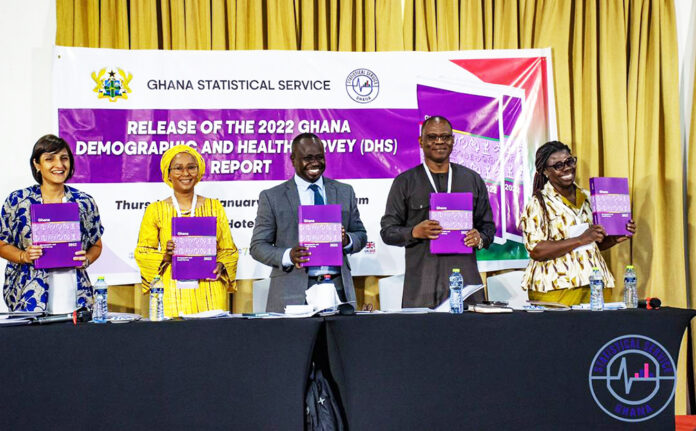Ghana has made a significant improvement in the fight against Malaria prevalence among children under-5 years, as it records 67% reduction, thus over 26% in 2014 to 8.6% in 2022.
This was revealed during the launch of 7th Ghana Demographic and Health Survey (GDHS) by the Ghana Statistical Service (GSS), in collaboration with the Ghana Health Service (GHS) and other development partners last Friday, in Accra.
The objective of the report is to achieve health-related Sustainable Development Goal (SDG) 5 targets, which require acceleration of efforts and investments.
The main report of 2022 GDHS presents an updated statistics on basic demographic and health indicators.
The launch marked the beginning of a series of dissemination activities aimed to engage key stakeholders involved in policy decision-making, planning, monitoring, and evaluation.
While Most of the regions in Ghana, especially the Greater Accra region, recorded a significant reduction of 11.2% to 2.0% – Northern region moved down from 38% to 10.6% – all in the 8 years span. Upper East Region continues to record a surge in Malaria prevalence, recording 11.7% to 12.2% increment.
The USAID Ghana Health Office Director, Dr. Zohra Balsara, who also addressed the gathering, indicated thatthe United States had worked with the Ghana Health Services’ National Malaria Elimination Program to deliver millions of bed nets, rapid malaria test kits and malaria medication – including malaria therapy for pregnant women and children under 5.
She further stated that they have scaled up laboratory diagnostics, trained health staff to improve the quality of malaria services and supported social and behaviour change, and together are making strides to prevent malaria and encourage early treatment.
The Government Statistician, Prof. Samuel Kobina Annim, who presented the survey highlighted that significant progress had been made over the 8-year period with about a third drop of the rate in 2014, which should be commended.
Emphasising on the increase in the Upper East Region, he advised that the country’s decentralisation efforts must be strengthened.
Other areas he highlighted from the GDHS Main report included access and behaviour viewpoints, where health improvements are a shared responsibility between individuals and the state.
“With respect to health seeking behaviour, for instance, about one-third (32.4%)of women 15 to 49 years visited a health facility or health provider in the six months period preceding, while one-fifth of men in this age range (20.4%) did so”, he added.
Prof. Kwabena Annim bemoaned the retrogression of some health indicators over time, citing an example from the survey report, which said childhood vaccination coverage remains lower than in previous surveys.
“Currently, 75% of children are vaccinated against all basic antigens, which is a decrease from 79% in the 2008 GDHS. The 2022 GDHS also shows a slight increase in the percentage of children with no vaccinations from 1% in the 2008 GDHS to 2% in 2022.Sexual violence increased by 1.1 percentage points between 2008 and 2022”, he disclosed.
According to him, based on the findings of the report, it is evident that achieving the Sustainable Development Goals 2, 3 and 5 targets will require acceleration of efforts and investments.
In a related development, in pursuit of attaining #zeromalaria for the nation, the Ministry of Health and the Ghana Health Service, with support from its partners, have unveiled the National Malaria Elimination Strategic Plan (NMESP) of Ghana for the years 2024 to 2028.
Under the theme: “Zero malaria starts now:Launching Ghana’s path to elimination”, the four year plan will not only outline the achievements made so far, but also underscores the interventions to be integrated with ongoing efforts for the realization of a malaria-free Ghana.
The primary objectives of the strategic plan are; to achieve a 90% reduction in malaria mortality by 2028, decrease malaria case incidence by 50% by the same year, and eradicate malaria in 21 districts characterized by very low malaria burdens.









